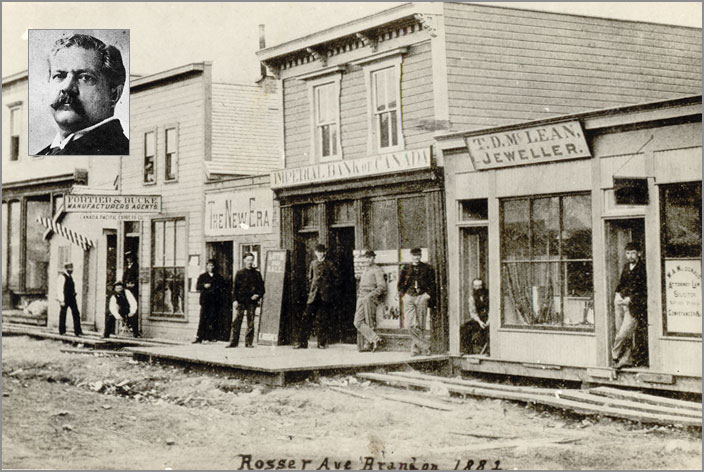
General Rosser's Legacy

Introduction


This inconspicuous
little article,
which
appeared in the Winnipeg Daily Times on May 16, 1881, is remarkable in
its lack of fanfare when one considers the impact General Rosser's
decision was to have on our province. Both the newspaper editors and
their readers, having witnessed countless tales heralding the next
great prairie metropolis, may be excused for missing the genuine
article here. For what they were witnessing was the birth of Brandon,
Manitoba's second city.
The text of following article was first published by Manitoba History
in its Fall 2007 tribute to Brandon's 125th Anniversary.
What’s
the connection between Rosser Avenue, Brandon’s
“Main” street, and the Rural Municipality of Rosser near
Winnipeg? How about the connection between The Battle of Little Bighorn
and the creation of Manitoba’s second city?
It all starts with the railway. At the beginning of 1881 what we now
call southwestern Manitoba was part of the Northwest Territories, as
the western provincial boundary stretched only slightly past Portage la
Prairie. It was, quite literally, not on the map. Specifically,
it was not on C.P.R. Chief Engineer Sanford Fleming’s map,
dated April 8th, 1880, and submitted as part of his report on possible
rail routes westward. He mentions that that the regions thereabouts had
“so far as known, have not been explored”. [1]
Though perhaps not explored, the territory had been considered in an
abstract way. Mr. Fleming, despite continuing to advocate for a
slightly more northern route along the Little Saskatchewan Valley and
skirting the Riding Mountains to the south, also envisioned a southerly
extension that would cross the Assiniboine near the mouth of the Little
Saskatchewan. He noted the agricultural potential of the region and
that it might become a site for a future city that would “shortly
become important”. [2]
This largely unpopulated area was slowly developing the first tentative
forays into agriculture with the noticeable beginnings of towns seen at
Rapid City, Minnedosa (Tanner’s Crossing), Millford (near the
confluence of the Souris and Assiniboine Rivers), and Grand Valley (a
few kilometers east of Brandon). These locations are mentioned in
the George Wyatt’s 1881 “Guide for Settlers”, which
includes a list of post offices and charts with destinations for both
steamboat and stagecoaches, [3] while the site that would later become
Brandon was an undeveloped homestead.
But before the end of 1881 this unassuming patch of riverside prairie
had become a bustling town with hotels, grocery stores, restaurants and
various outfitters popping up like crocuses on the sunny side of a
hill. Now, in any normal prairie town, activity of this sort would be
taking place on Main Street; or on a main street by any of the other
generic names: Front Street, Railway Street, sometimes even Commercial
Avenue. Even Winnipeg has a Main Street.
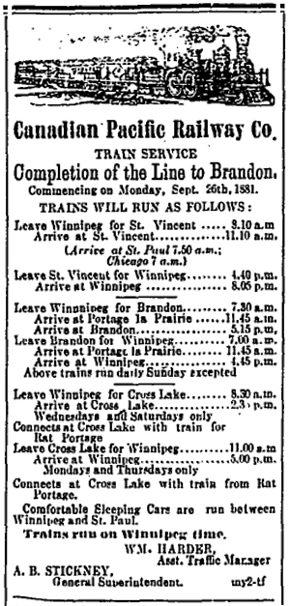 Winnipeg
Times,Nov. 15,
1881
Winnipeg
Times,Nov. 15,
1881
But
Brandon, instead, has Rosser Avenue and it was named after the
C.P.R.‘s Chief Engineer who established the site: Thomas
Lafayette Rosser. That’s a considerably enduring tribute
considering that the man worked for the C.P.R for less than a year and
departed in the midst of accusations, recriminations and scandal.
And also considering that lesser avenues bear the names of two of
Rosser’s bosses, Van Horne and Stickney.
But then Rosser was not your ordinary railroad engineer. In fact, it is
proper to refer to him as General Rosser, an American no less,
southerner even, and a well-respected veteran of the American Civil War.
That said, the man liked naming things and in his short time in our
province invoked his admiration for fellow countryman Stonewall Jackson
by bestowing that name on an upstart town just north of Winnipeg and
had his own name attached to a village and a municipality also near
that city. He even had the village of Griswold, near Brandon, named
after one of his American friends. [4] You might say that he left his
mark.
In the spring of 1881 this former soldier, well into his second career
as a Railway Chief Engineer, crossed the Assiniboine River at a point
about 200 kilometres west of Winnipeg, bargained briefly with a Mr.
Adamson and purchased the townsite of Brandon for little more than a
song. As with many other deals struck in the creation of railway towns
in the era, potential profit for Mr. Rosser was a consideration [5].
He’d just rejected the site known as Grand Valley, the
area’s most well-established settlement, a few kilometers
downriver in a famous confrontation with area pioneer John McVicar, who
had his own notions about profit.
 Winnipeg
Daily Times
July
12, 1881
Winnipeg
Daily Times
July
12, 1881
The story of
the founding of Brandon has often been told, in its various and
conflicting forms. Where does fact give way to legend? Do we believe
Mrs. Dougald McVIcar. sister-in-law of the Grand Valley property owner,
who makes no mention of Rosser’s offer to purchase the town site.
[6] How reliable are the various other accounts that have McVicar
falling victim of bad advice from cronies? What about Brandon pioneer
Beecham Trotter’s account wherein McVicar immediately asks for
double what Rosser was willing to pay, only to be stung by
Rosser’s, equally quick reply, ”I’ll be damned if a
town of any kind is ever built here.” [7] The most reliable
account may be found in the memoirs of James Secretan, a C.P.R.
surveyor who worked with Rosser. He recalls that Rosser indeed made a
$25000 offer, and when McVicar did counter with a request for $50000,
the General abruptly ended negotiations and moved on upstream. [8]
Upon taking the suggestion of the captain of the prairie steamboat the
Marquette, and naming the city Brandon in a nod to the nearby hills and
former HBC post, he set about putting his stamp on the community. It
was General Rosser who ordered the surveyor Mr. M. P. Hawley to keep
the lots of the new city small, and the streets narrow (66 ft as
opposed to 99) - more profit was the first concern. [9]
If this and other decisions benefited Rosser, one must also acknowledge
the benefit to both his employer the C.P.R. and to the public.
His policy of avoiding established towns, first evidenced in the Grand
Valley episode, saved a fortune. The decision to establish the C.P.R.
headquarters in Winnipeg was a sensible business decision and certainly
good for Manitoba, and of all the decision he made, his selection of
the site of Brandon has had the most lasting impact.
Who exactly was this “General Rosser”? There seemed to be a
lot of Generals and Colonels involved in the opening of the west.
According to one of his surveyors, James Secretan, whom Rosser
appointed to take charge of the line west, he was ”…
a most lovable man… a tall, handsome, swarthy Southern gentleman
of the real old type, had fought in the ‘late
unpleasantness,’” [10] Biographer Thomas Beane
referred to him as “a superb horseman, tall and muscular, with a
firm jaw and a manner that exuded self-confidence.” [11]
He was, in
fact, a Confederate Major General of Cavalry during the American Civil
promoted to command by Confederate Army leader J.E.B. Stuart who cited
his leadership, bravery and tactical ability. [12] That’s a
pretty good resume, but on the other hand, biographers also note that
he was a man driven by a quest for financial gain, and a person who
could be “arrogant, aggressive, racist, and proud to a
fault.” [13]
There is general agreement that, in an age when many self-important
people tended to attach questionable military ranks to their identity,
Mr. Rosser, in fact had earned his rank in battle.
He was indeed complex person, and undeniably, one with many talents and
a wide variety of experiences. The two key aspects of his
character: his almost ruthless, action-oriented approach to getting a
job done, and his ever-present eye on the possibilities for profit, are
amply demonstrated through his actions during his short time with the
C.P.R.
It turns out that this authentic Confederate General was also a
West Point classmate and friend of the illustrious General Custer, he
of Little Bigfoot fame. It reminds one that the west was indeed a small
place in those days and that, especially in this region, history
intertwined often on a north-south axis regardless of borders. How did
a Confederate General end up in Grand Valley as advance man for our
national dream?
Rosser, who was born in Virginia in 1836, spent his youth on the Sabine
River near the Texas-Louisiana border before entering West Point in
1856. Just weeks before graduation, the outbreak of the Civil War
caused him to skip that formality and head home to enlist the new
Confederate Army. His colleague and friend, George Armstrong Custer,
class clown and all-round hell-raiser, being from the north was able to
stay on and finish.
Lieutenant Rosser soon distinguished himself as a cavalry officer, and
moved up the ranks quickly. Superiors, in particular, noticed his
calmness under fire and his ability to mould groups of raw recruits
into an efficient fighting machine. He was a perfectionist who took
great pride in his accomplishments.
From all reports he developed a flair for the dramatic. Perhaps
he had taken to reading his own press. Describing a difficult situation
during the turning point Gettysburg campaign he later reported: "The
enemy greatly outnumbering us, appeared in force everywhere, and it
became apparent that victory was the only means of escape." [14]
And escape he
did,
and although the war continued to go badly for the South, and Rosser
himself sustained several serious injuries, he continued to be a
formidable presence, harassing the Union forces wherever he encountered
them, capturing supplies, never avoiding a fight. [15] In fact he was
so successful that the Union commander General Sherman ordered one of
his young up-and-comers, George Custer to deal with his former
classmate. Thus began a series of engagements and a gentlemanly rivalry.
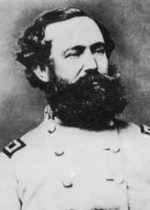
General
Rosser in Uniform
A now famous battle against Custer at Tom’s
Brook (Oct 8,1864) in
the Shenandoah Valley saw Custer with his customary flare for the
dramatic, or perhaps mere gentlemanly courtesy, ride between the lines
before the onset of hostilities and deliver a gracious low bow to his
worthy opponent. Rosser acknowledged the gesture with a smile and
explained to his staff, “You see that Yank down there
bowing? Well that’s General Custer, the Yanks are so proud of,
and I’m going to give him the best whipping he ever got”.
[16] It wasn’t to be. Custer easily prevailed this day in a
contest later dubbed the “Battle of the Woodstock Races”.
The moment, like so many in Custer’s career has been recorded for
posterity in a drawing.
Custer, at one point, was fortunate enough to be able to capture
Rosser’s luggage complete with a uniform. He wrote his friend
thanking him for the wardrobe addition and suggesting that Rosser have
his tailor make the coattails of his next uniforms a little shorter to
accommodate his (Custer’s) shorter stature. [17]
As we all know, it was in a losing cause. But Rosser wasn’t
inclined to “cut and run” as they say today. He earned
himself a place in the history books, and perhaps some grudging respect
from the victors for refusing to surrender his unit when everyone else
could see it was all over.
With his military career cut short by the end of the Confederacy,
Rosser, with scant success, tried various job and business enterprises
until in1869, like so many others, he headed west. There he landed a
“starting level” position with a small railway concern and
quickly established himself in this the growth industry of the
mid-nineteenth century. [18] The building of railways across the
“untamed” west offered travel and adventure, even a bit of
danger. It was almost as good as the army! And Rosser rose just
as quickly. Starting at the bottom he worked his way from roadman, to
scout, chief surveyor and, soon enough, Chief Engineer of the Northern
Pacific Railway. [19]
As he engaged in the task of surveying the line westward through
Montana there was some resistance and harassment from the local
inhabitants the Sioux, who for good reason didn’t trust the
intentions behind this intrusion into what they had every reason to
suppose was their home. To the rescue came old friend Custer, who,
being on the winning side of the recent north-south conflict,
hadn’t had to give up his profession. The victorious North
hadn’t waited too long for a new enemy to appear and what we
charitably refer to as the Indian Wars was underway, with Custer as a
central figure.

George
Armstrong Custer
Classmate, rival, and
friend of General Rosser.
This
military-railway collaboration was perhaps the first of what some would
insist became a trend in the U.S.; the use of military force to back
the interests of large corporations whose endeavors are identified with
the natural interest. It didn’t do much for relations with the
west’s natives.
The meeting of Rosser and Custer in a camp on the Northern Pacific line
must have been like a reunion of old friends. They no doubt recounted
old times and those see-saw series of battles and skirmishes along the
Shenandoah Valley and the exchange of notes and friendly jibes. [ 20 ]
Rosser’s friendship for Custer was perhaps most famously
displayed after Custer’s demise at Little Bighorn. With the
Custer legacy under attack, and the President himself beginning to lay
blame, Rosser jumped to the defense of his former adversary. In a
letter to the Chicago Tribune he puts the blame for the disaster on the
shoulders of Custer’s subordinates:
“I feel that Custer would have succeeded had Reno with all
the reserve of seven companies passed through and joined Custer after
the first repulse. I think it quite certain that General Custer had
agreed with Reno upon a place of junction in case of a repulse of
either or both of the detachments, and instead of an effort being made
by Reno for such a junction as soon as he encountered heavy resistance
he took refuge in the hills, and abandoned Custer and his gallant
comrades to their fate.
As a soldier I would sooner today lie in the grave of General Custer
and his gallant comrades alone in that distant wilderness, that when
the last trumpet sounds I could rise to judgment from my post of duty,
than to live in the place of the survivors of the siege on the
hills.” [21]
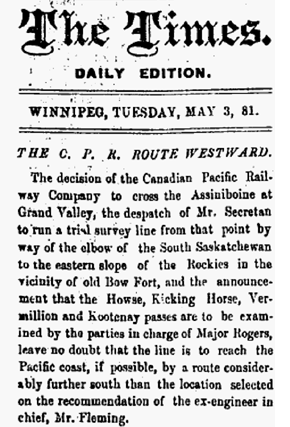
The
Winnipeg Daily Times, May 1, 1881
Rosser was soon
forced to retract his impetuous attack on Reno, under threat of
lawsuit, [22] but his spirited defense of Custer, aside from accurately
highlighting a central point of a fascinating controversy, is
indicative of a relationship that is much easier to understand when
taken in the context of the times. The Civil War provided countless
stories of close friends and even family members taking opposite sides.
In any case Rosser and Custer made a good team, and the survey into
Montana was a particularly dangerous operation. Rosser himself usually
carried a rifle, a brace of pistols, and saddle bags full of ammunition
when traveling and once had occasion to use his weapons in a stand-off
with Sioux who had just killed his co-worker and friend. [23]
At that time, James Jerome Hill, a former Canadian based in St. Paul,
Minnesota, was the president of the St. Paul, Minneapolis and Manitoba
Railway, a company he had taken over at the verge of bankruptcy and
turned into a gold mine. [24] By 1881 he was a member of the Montreal
syndicate with the first C.P.R. contract, something he had at first
undertaken with the hope of uniting it with the lines south of the
border, thus creating the beginnings of a western transportation
empire. At that time many thought that an all-Canadian route,
north of the Great Lakes, through the Canadian Shield was neither
advisable, nor economically feasible. The logical route was to go south
of the lakes, through the United States, and through Pembina and on to
Selkirk. Logical that is, if from a Canadian perspective, one forgets
the political implications; or from the American perspective, one fully
expects the US to control the entire west in any case. In the meantime,
Mr. Hill was a man with a track record and when he needed someone to
solve problems in the operations north of the border he called on
Rosser.
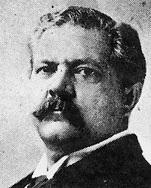
Thomas L.
Rosser in the
1870's
And what was in it for
Rosser? A reasonable salary, to be sure, the
element of challenge and fact that Rosser had worked with Hill briefly
on the “Manitoba Road”, were all factors. [25] But there
was also the tacit understanding that it wouldn’t be totally out
of line to use one’s influence and inside information to make a
few extra bucks. At least that’s the way Rosser seemed to
see it.
The establishment of a railway in undeveloped country is the original
ground floor opportunity for a venture capitalist. The laying of the
rails is the first step in the creation of the new map of the area.
Everything rides on a few key decisions. The locations of the general
route, specific route, divisional points and sidings all determine the
location of towns. The growth of those towns depends largely on the
railways use of that town. Divisional points, located about every 300
kilometres will be major supply centres, while stations or sidings will
be less important. Either way, railway decisions will be the key
determinant of land values in a given settlement.
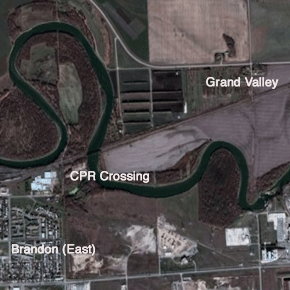
Google
Earth
Rosser had been
through all this before with The Northern Pacific. He had been
responsible for selecting townsites, and crossings – in fact his
selection of crossing of the Red River at Fargo, and the land
speculation profits he is assumed to have garnered, was the beginning
of his personal fortune. [ 26 ]
Originally the C.P.R. was to cross the Red at Selkirk, a preferred
crossing in that the area near Fort Garry at the forks of the
Assiniboine and Red was prone to flooding and that the route was then
to follow the flat, easily-crossed area we now call the Interlake,
through the narrows of Lake Manitoba and northwest towards the
Saskatchewan River. The Carleton Trail, already in use for
decades, followed the Saskatchewan River to Edmonton, and from there
the Rockies were to be breached at the Yellowhead Pass.
The choice of this route was based on exhaustive research by two
extensive exploratory expeditions. John Palliser, an Irish gentleman
adventurer, who had already traveled widely in the American West was
selected by the Royal Geographical Society and the Imperial Government
to explore the area between Lakes Superior and the Rockies and report
on everything from plant species to possible travel routes. After a
two-year field trip he concluded that the only good land in the area
lay in a belt along the North Saskatchewan. In fact the vast area
comprising the southern third of Saskatchewan and Alberta, now called
Palliser’s Triangle, was deemed thoroughly unsuited to
agriculture. [27]
Another expedition, sponsored by Canada and lead By Henry Youle Hind, a
geology professor from Toronto, came to similar conclusions. There was,
apparently, no real future for the southern prairies. Normally,
railways are built where the customers are. In this case the railways
came before the customers, so it was a case of deciding where the
customers would end up.
And that’s the way it stood when General Rosser rode into the
picture in the spring of 1881. He was at the table, when James Hill and
the Executive Committee of the C.P.R. changed the history of the
Canadian West. In short order they decided that the route across the
prairies, instead of following the northern route would take a much
more southern route, essentially where it now exists through Brandon,
Regina, Calgary and the Kicking Horse Pass. As to the reason for
this dramatic reversal of policy, one theory is that it all turned on
the work of one man, John Macoun. For he too was at that famous
meeting. [28]
Macoun had
accompanied Sanford Fleming on his first survey of the Carleton Trail
route ten years earlier, and returned for extensive research in 1879
and 1880. His observations were that the southern prairies were indeed
well situated for agriculture. Now we know that the reason for the
differing points of view are a simple as the cycle of drought normal to
this prairies region. Palliser and Hind made their observations in
1857-59, the centre of a dry spell. Macoun in 1879 and 1880 witnessed
the wettest years of the century. [29]
The decision, or more significantly, its approval by the government,
may also have rested on a few other foundations. Politically it was
advisable to located closer to the American border to preempt possible
competition from an American line and to keep a firm grip on the
territory at a time when many prominent Americans viewed the annexation
of the west by the US as not only desirable, but inevitable. On a more
practical note we were probably seeing the beginnings of the
C.P.R’s policy of avoiding high prices and land speculation by
bypassing expected routes and established communities. They truly were
doing the unexpected in this case. Additionally the southern route was
shorter and would be (they thought!) less expensive to build. Some have
speculated Mr. Hill saw the possibility of some arrangement whereby his
other venture the Great Northern in the U.S. would benefit from some
arrangements with the C.P.R. [30]
So it was that in early May
of 1881 we find Rosser at the end of the
line near Portage La Prairie turning the sod to start what would be a
season of frantic activity for the largely uninhabited stretch of
prairie to the west. As they proceeded, General Rosser and his
boss, Alpheus B. Stickney quickly found that creating new towns was
also more profitable for them personally than using already existing
ones. It was a short-lived relationship, but various reports have
the pair making $130000 between them during their brief careers with
the C.P.R. Not a bad haul in 1881 dollars. [31]. As an example of
what could be done, Rosser was suspected of having had the preliminary
survey of the line in Saskatchewan altered to bring in through present
day Regina where he had invested. [32]
They made a lot of money, but it did not go unnoticed. The local press,
especially in existing centres where hopes and speculations were dashed
by C.P.R. decisions, raised a hue and cry and almost before it began,
Rosser’s career as a railway entrepreneur was over.
First, Stickney was replaced by William Cornelius Van Horne. Perhaps it
was the bad press, or perhaps he actually was alarmed at the
Rosser/Stickney speculations, but one of Van Horne’s first acts
was to dash of a telegram firing Rosser. Rosser deemed it an
inconvenient time to be sacked, ignored the message, and left town on
urgent business. Van Horne again asked Rosser to resign. Lawsuits and
harsh words ensued. In a famous incident in a Winnipeg club pistols
were produced and only the intervention of friends prevented bloodshed.
[33]
Macoun had
accompanied Sanford Fleming on his first survey of the Carleton Trail
route ten years earlier, and returned for extensive research in 1879
and 1880. His observations were that the southern prairies were indeed
well situated for agriculture. Now we know that the reason for the
differing points of view are a simple as the cycle of drought normal to
this prairies region. Palliser and Hind made their observations in
1857-59, the centre of a dry spell. Macoun in 1879 and 1880 witnessed
the wettest years of the century. [29]
The decision, or more significantly, its approval by the government,
may also have rested on a few other foundations. Politically it was
advisable to located closer to the American border to preempt possible
competition from an American line and to keep a firm grip on the
territory at a time when many prominent Americans viewed the annexation
of the west by the US as not only desirable, but inevitable. On a more
practical note we were probably seeing the beginnings of the
C.P.R’s policy of avoiding high prices and land speculation by
bypassing expected routes and established communities. They truly were
doing the unexpected in this case. Additionally the southern route was
shorter and would be (they thought!) less expensive to build. Some have
speculated Mr. Hill saw the possibility of some arrangement whereby his
other venture the Great Northern in the U.S. would benefit from some
arrangements with the C.P.R. [30]
So it was that in early May of 1881 we find Rosser at the end of the
line near Portage La Prairie turning the sod to start what would be a
season of frantic activity for the largely uninhabited stretch of
prairie to the west. As they proceeded, General Rosser and his
boss, Alpheus B. Stickney quickly found that creating new towns was
also more profitable for them personally than using already existing
ones. It was a short-lived relationship, but various reports have
the pair making $130000 between them during their brief careers with
the C.P.R. Not a bad haul in 1881 dollars. [31]. As an example of
what could be done, Rosser was suspected of having had the preliminary
survey of the line in Saskatchewan altered to bring in through present
day Regina where he had invested. [32]
They made a lot of money, but it did not go unnoticed. The local press,
especially in existing centres where hopes and speculations were dashed
by C.P.R. decisions, raised a hue and cry and almost before it began,
Rosser’s career as a railway entrepreneur was over.
First, Stickney was replaced by William Cornelius Van Horne. Perhaps it
was the bad press, or perhaps he actually was alarmed at the
Rosser/Stickney speculations, but one of Van Horne’s first acts
was to dash of a telegram firing Rosser. Rosser deemed it an
inconvenient time to be sacked, ignored the message, and left town on
urgent business. Van Horne again asked Rosser to resign. Lawsuits and
harsh words ensued. In a famous incident in a Winnipeg club pistols
were produced and only the intervention of friends prevented bloodshed.
[33]
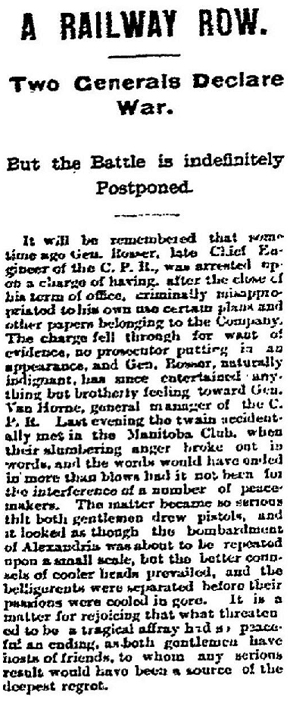 Winnipeg
Daily Sun. Juily 13, 1882
Winnipeg
Daily Sun. Juily 13, 1882
The end result
was that Rosser sued for malicious prosecution, asking for $20000 and
getting $2600, [34] then took his “earnings” home to
Virginia where he dabbled in farming and in a succession of imaginative
business ventures that never seemed to make it past the planning stage.
By the 1890’s he was the most prominent living Civil War veteran,
now slipping into the role of American Patriot. He did get one more
shot at a military career, this time as trainer of recruits for the
Spanish-American War in 1898. At the time his death in 1910 he was
Postmaster of Charlottesville, Virginia, a political appointment he had
secured in 1905. [35)
And here in Canada, his legacy is mixed, or worse still, unconsidered.
By most standards, his accomplishments are noteworthy. In that
crucial summer of 1881, when the laying of the tracks set in motion the
pattern settlement would take, Rosser certainly tackled the task at
hand. Supplies were purchased and delivered, men were hired, supervised
and provided with food, towns were created. As Beecham Trotter, who
worked on the railways that summer, so aptly noted in his account of
the times, it was all done with the focus being the day-to-day, no one
being overly conscious that history was being made. [36] There
were lines to grade, bridges to be built and deals to be made.
So, tempted as we may be to find fault with some of General
Rosser’s healthy regard for his own financial self-interest, we
should examine his record through the lens of time and
circumstance. To this day it is difficult to find fault with
Rosser’s decisions regarding town sites, even if they also
benefited him personally, and his work in pushing the rails westward
during the summer of 1881 has perhaps not been fully recognized for
what it was; a job very well done.
Conclusion
No details were provided for these items in the Winnipeg paper, but one
gets the message.
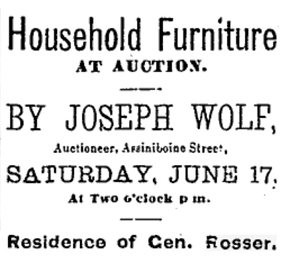 Winnipeg
Daily Times, June
14, 1882
Winnipeg
Daily Times, June
14, 1882
 Winnipeg
Daily Times, May 7, 1883
Winnipeg
Daily Times, May 7, 1883

Bibliography
1. Fleming, Sandford, C.M.G., Report : Canadian Pacific Railway 1880,
(Ottawa,: Maclean, Roger & Co.1880), Appendix 15, 248. (The map
referred to is Plate 7 on page 232)
2. Fleming, Sandford, C.M.G., Report : Canadian Pacific Railway 1880,
248.
3. Wyatt, George H. A reliable guide for settlers, travellers
& investors in the city of Winnipeg, Manitoba and the new
North-West (Toronto) 1881, 3-4
4. Alpheus B. Stickney (1840-1916) an American with extensive
experience in railroad construction, who, like Rosser had worked with
J.J.Hil on his St. Paul, Minneapolis and Manitoba Railway, was
appointed General Superintendent of the C.P.R. in April of 1881 and was
Rosser’s immediate superior. He resigned in October of that same
year amid accusations that he was speculating on Manitoba properties
based on his knowledge of routes.
Manitoba History Biographies, Alpheus Beede Stickney (1840-1916)
http://www.mhs.mb.ca/docs/people/stickney_ab.shtml
5. William Cornelius Van Horne (1843-1915) was hired as general manager
of the C.P.R. by J.J. Hill in the fall of 1881, replacing A.B.
Stickney. Van Horne, an American who left his post as the general
manager of the Chicago, Milwaukee and St. Paul Railroad to take on the
Canadian position, is generally credited with providing the leadership
and drive required to finish C.P.R. line across the Prairies and
through the Rockies. Berton, Pierre The Last Spike, 44 : Lavallee,
Omer, John M. Egan, A Railway Officer in Winnipeg, 1882-1886:
An account of Canadian Pacific’s first years in the Manitoba
capital, MHS Transactions, Series 3, Number 33, 1976-77 Season
6. Rudnyckyj, J.B., Manitoba Mosaic of Place Names, (Winnipeg MB,
Canadian Institute of Onomastic Sciences), 89; Geographical Names of
Manitoba, (Manitoba Conservation Winnipeg, 2000); Sources offer no
details about Mr. and Mrs. Griswold or their relationship with Rosser.
7. Van Rhyn, M. (1998). An American warrior Thomas Lafayette Rosser
1836-1910 (Thesis (M.A.)--University of Nebraska—Lincoln), 1998,
79.
8. McVicar, Mrs. Dougald, Reminiscenses of early Brandon (Unpublished
Memoir, 1946)
9. Trotter, Beecham, A Horseman and The West (Toronto: Macmillan
Company of Canada Ltd., 1925), 89
10. Secretan, James Henry Edward,Canada's great highway: From the first
stake to the last spike (Ottawa: Thorburn & Abbott, 1924), 125-128;
Berton. Pierre, The Last Spike (Toronto: McLelland and Stewart
Ltd., Toronto 1974), 25; Berton relates conflicting accounts by J.H.E.
Secretan, a CPR surveyor and memoirs of Charles Aeneas Shaw, a
“locating engineer”; Doerksen, A. D., The Brandon
Wheat Kings - 1887 Vintage (Manitoba Pageant, Winter 1977, Volume 22,
Number 1) favours the account of Trotter. The evidence indicates,
at the very lweast, a lost oportunity for McVicar and the Grand
Valley speculators.
11. Berton. Pierre, The Last Spike, 29
12. Secretan, James Henry EdwardCanada's great highway: From the first
stake to the last spike), 88
13. Beane, T. O. Thomas Lafayette Rosser, soldier, railroad
builder, politician, businessman (1836-1910) (Thesis (M.A.)--University
of Virginia, 1957), 23
14. Beane, T. O. Thomas Lafayette Rosser, soldier, railroad
builder, politician, businessman (1836-1910) (Thesis (M.A.)--University
of Virginia, 1957), 53
15. Van Rhyn, M., An American warrior Thomas Lafayette Rosser
1836-1910., iv
16. Minor, David, “Under Two Flags”, Eagles Byte Research
http://home.eznet.net/~dminor/O&E988.html
August 1998 No. 32
17. Beane, T. O.. Thomas Lafayette Rosser, soldier, railroad builder,
politician, businessman (1836-1910), 40-48
18. Beane, T. O. (1957). Thomas Lafayette Rosser, soldier, railroad
builder, politician, businessman (1836-1910). 44
19. Minor, David, Under Two Flags
20. Beane, T. O., Thomas Lafayette Rosser, soldier, railroad builder,
politician, businessman (1836-1910)). 55-57
21. Van Rhyn, M., An American warrior Thomas Lafayette Rosser
1836-1910. 78
22. Beane, T. O., Thomas Lafayette Rosser, soldier, railroad builder,
politician, businessman (1836-1910)). 60
23. From a letter by General T. L. Rosser, to the Chicago Tribune
(8th July, 1876). (Also cited in Boots and Saddles)
24. Van Rhyn, M., An American warrior Thomas Lafayette Rosser
1836-1910, 95
25. Van Rhyn, M., An American warrior Thomas Lafayette Rosser
1836-1910, 87
26. Berton, Pierre, The National Dream (Penguin Books
Canada,1989), 406-407
27. Cruise, David and Griffiths, Alison, Lords of the Line
(Markham: Penguin Books Canada Ltd., 1988), 129
28. Beane, T. O., Thomas Lafayette Rosser, soldier, railroad builder,
politician, businessman (1836-1910), 57
29. Berton. Pierre,The Last Spike, 14
30.
Macoun, John, Autobiography of John Macoun, M.A.: Canadian explorer and
naturalist, assistant director and naturalist to the Geological Survey
of Canada, 1831-1920 (Ottawa, 1922), 183,184
31. Berton. Pierre, The Last Spike, 11-12
32. Cruise, David and Griffiths, Alison, Lords of the Line, 101
33. Cruise, David and Griffiths, Alison, Lords of the Line, 129
34. Berton. Pierre, The Last Spike, 113 Berton lists no specific no
source for his belief.
35. Cruise, David and Griffiths, Alison, Lords of the Line, 130;
Berton, The Last Spike, 91; Both Berton and Cruise & Griffiths draw
the account from the Winnipeg Sun, July 13, 1882
36. Berton. Pierre, The Last Spike, 91 Berton
37. Beane, T. O., Thomas Lafayette Rosser, soldier, railroad builder,
politician, businessman (1836-1910)). 81
38. Trotter, Beecham, A Horseman and The West, 102
General References and Suggested Reading
Barker, G.F., Brandon: A City (Self-Published, 1977)
Beane, T. O. Thomas Lafayette Rosser, soldier, railroad builder,
politician, businessman (1836-1910) (Thesis (M.A.)--University of
Virginia, 1957)
Berton, Pierre, The National Dream (Penguin Books Canada,1989)
Berton, Pierre, The Last Spike (Toronto: McLelland and Stewart
Ltd., 1971)
Brown, Roy, The Brandon Hill Connection, (Tourism Unlimited, Brandon
MB.)
Brown, Roy, The Fort Brandon Story, (Tourism Unlimited, 158 8th St.
Brandon Mb.)
Brown, Roy, Steamboats on the Assiniboine, (Tourism Unlimited, Brandon
MB)
Coates, Ken, and McGuiness, Fred, Manitoba : The Province and
People (Hurtig Publishers, Edmonton, 1987)
Coates, Ken, and McGuiness, Fred, The Keystone Province : An
Illustrated History of Manitoba Enterprise (Windsor Publications,
1988)
Connell, Evan, S. Son of the Morning Star; Custer and the Little
Bighorn, (Harper Perennial, New York, 1985)
Cruise, David and Griffiths, Alison, Lords of the Line (Markham:
Penguin Books Canada Ltd., 1988)
Custer, E.B., Boots and Saddles or, Life in Dakota with General Custer.
Scituate, Mass: Digital Scanning 1999,
Fleming, Sandford, C.M.G., Report : Canadian Pacific Railway 1880,
(Ottawa,: Maclean, Roger & Co.1880)
Gibbon, John Murray L., The Romantic History of the Canadian Pacific,
(Tudot Publishing Company, New York, 1937)
Hutton, Andrew (Ed.),The Custer Reader, (U of Nebraska Press 1992)
Lavallee, Omer, John M. Egan, A Railway Officer in Winnipeg, 1882-1886:
An account of Canadian Pacific’s first
years in the Manitoba
capital, MHS Transactions, Series 3, Number 33, 1976-77 Season
Macoun, John, Autobiography of John Macoun, M.A.: Canadian explorer and
naturalist, assistant director and naturalist to the Geological Survey
of Canada, 1831-1920 (Ottawa, 1922)
Also at: http://peel.library.ualberta.ca/bibliography/4612.html
Manitoba Conservation, Geographical Names of Manitoba, Winnipeg, 2000
Manitoba History Biographies, Alpheus Beede Stickney (1840-1916)
http://www.mhs.mb.ca/docs/people/stickney_ab.shtml
McVicar, Mrs. Dougald, Reminiscences of early Brandon (Self-Published)
Morton, W.L., Manitoba : A History, (University of Toronto Press, 1957)
Kavanagh, Martin, The Assiniboine Basin, (The Gresham Press, Old
Woking, Surrey, England 1966 Ed.)
Secretan, J.H.E., Canada’s Great Highway: From the First Stake to
the Last Spike (London, 1924)
Also at:http://peel.library.ualberta.ca/bibliography/4949.html
Steen & Boyce. Brandon, Manitoba, Canada, and her industries
(Winnipeg: Steen & Boyce, 1882)
Trotter, Beecham, A Horseman and The West (Toronto: Macmillan
Company of Canada Ltd., 1925)
Van Rhyn, M., An American warrior Thomas Lafayette Rosser 1836-1910
(Thesis (M.A.)--University of Nebraska--Lincoln, 1998)
Welsted, John, Everitt, John, And Stadel, Christoph : The Geography of
Manitoba : Its Land and People (University of Manitoba Press)
Wheeler, Richard S. An Obituary for Major Reno, (Tom Doherty Associates
Book, New York, 2004)
Wyatt, George H. A reliable guide for settlers, travellers &
investors in the city of Winnipeg, Manitoba and the new
North-West (Toronto: s.n., 1881.)
http://peel.library.ualberta.ca/bibliography/1021.html
|